“Only in adoration can profound and true acceptance develop. And it is precisely this personal act of encounter with the Lord that develops the social mission which is contained in the Eucharist and desires to break down barriers, not only the barriers between the Lord and us but also and above all those that separate us from one another.”
Pope Benedict XVI
A foreword by Ha Phuong
Adoration is rich in the religious color of worship. Dating back to the age of Classical Rome, adoration had taken its form in the act of hand or robe-kissing upon the gaze of the sovereign. Catholics pray to Jesus Christ before the Eucharist at their local parish to express their deepening homage to Him. Adoration draws intimacy to the greatness, which often takes the form of the Almighty and his earthly fellows – the Saints, Kings, and Heralds, who may bless us with those gifts of wisdom, graciousness, and epiphany in return for our pure adoration.
But to the deepest nature of adoration, there is affection. Not the fleeting fondness of a nice little souvenir on a department store’s glass shelter; not the simple favor of a pretty-looking figure you pass by on the street, but the passionate and devoted love towards a person, a thing, a notion that turns you into its most faithful dearest. Without passion, adoration makes no difference from mere respect, as it is not the awe towards an entity of great dignity or power, but the worship that “praise even every piece of land that her footsteps go on”.
Adoration is a love that craves no rewards or bidding, but the complacency of devotion. Even if the river dries up and the rocks wear away, the eyes with adoration gaze upon their adored sparkle for eternity; other people fear that their love can never be responded to, but a person with adoration will love one to the end of the world, with the pride that even not answered, he will never regret.
In the atmosphere of the Thanksgiving day, immerse yourself in the arts that adoration embodies. May eternal love be with us, though under the roof of your dear house, in the dripping sound of the rain somewhere far away from home, or on some binding lights lone streets.
What to read
“The Song of Achilles” by Madeline Miller, recommended by Aini
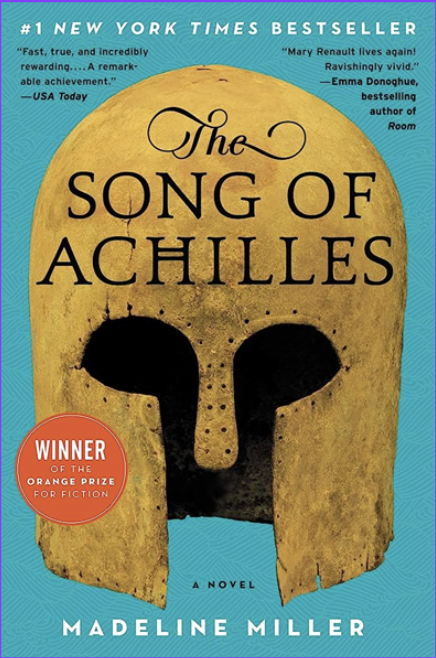
“We were like gods at the dawning of the world, and our joy was so bright we could see nothing else but the other.”
Filling in the gaps left by prior narratives, it presents a heartfelt and genuine love story amidst the chaos of the Trojan War. Miller goes beyond, humanizing Achilles through Patroclus’ perspective. Seen by many as a beautiful son of a goddess and a king, undefeatable, mighty, and arrogant, we are revealed to his humanity — his tenderness, cluelessness, and fury.
“He is half of my soul, as the poets say.”
A slow burn love story that is sentimental without excessive declarations, a relationship that is poignant without overwhelming emotions, and a narrative about two men who are human, flawed, and imperfect, yet each bearing depth of character and strong principles while fiercely protective of one another.
“Achilles’ eyes were bright in the firelight, his face drawn sharply by the flickering shadows. I would know is in the dark or disguise, told myself. I would know it even in madness.”
“To Sir, With Love“ by E.R. Braithwaite, recommended by Rithika

A 1959 autobiographical novel set in a secondary school classroom, To Sir, With Love not only beautifully handles poignant themes of overcoming bigotry and racial prejudice in post-World War II London, but it delivers a heartwarming story of a black teacher’s efforts to uncover the potential of a class full of delinquent children tainted with the same racial bias that Braithwaite has been familiar with all his life.
Throughout the course of the novel, readers relish in the growing adoration and respect the students gain for their new teacher and the profound realizations they have about the world around them with his assistance. It’s impossible to put this novel down without having been irrevocably moved and appreciative of the way our educators have shaped us as human beings.
What to Listen
Curated by Mini, Egeman, and Hazal
What to watch
“Adoration” by Fabrice Du Welz, recommended by Anna

The movie explores first love through the eyes of two children, one of whom happens to suffer from paranoid schizophrenia.
Paul, living on the grounds of a mental institution with his psychologist mother, meets Gloria, a patient at the institution. The film takes a darker turn as Paul helps Gloria escape in order to take her to her grandpa’s house. Having not grown up around other kids, Paul is innocent and naive and his only friends were the birds he encountered in the forest near his home. His life takes a significant twist when he decides to join Gloria on her journey, forced to grow up quickly as they encounter various obstacles in the wilderness— yet it doesn’t change the fact that he is still a child.
The film captures Paul’s character through his repeated decisions to stay with Gloria, highlighting his deep adoration and devotion to her despite her toxic behavior towards other people and even towards him—she physically hurts him multiple times, she sets a couple’s boat on fire, she kills someone… The camera skillfully focuses on Gloria’s hypnotic blue eyes, allowing viewers to understand Paul’s fascination with her even in the midst of unique circumstances.

“Les Hermes Folles” by Wild Grass, recommended by Francesca
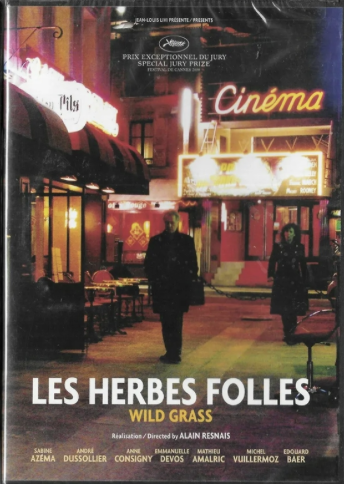
Les Herbes Folles” (Wild Grass) is a French film based on the novel “L’incident” by Christian Gailly.
The story revolves around the unexpected and mysterious connection between two strangers: Georges Palet, who finds a lost wallet, and Marguerite Muir, the owner of the lost wallet. The attempt to return said wallet sets the stage for a story that delves into the complexities of desire, fascination, and the blurred lines between admiration and obsession. George’s initial curiosity evolves into an infatuation that goes beyond conventional boundaries.
The film explores how admiration, when taken to extremes, can transform into an all-encompassing obsession, blurring the line between genuine affection and something more unsettling. Moreover, it invites viewers to reflect on the nature of human connections and the fine line between admiration and unhealthy obsession.
The incipit is already showing the development of events under a certain light: she’s in a shoes shop, he’s in a watch shop and then, by a twist of faith, they meet, and the viewer cannot avoid noticing the visible passion in their eyes that will decide their destiny. Their complicated relationship, made of contradictions, desire, lies and frustration will be given many chances because that’s what the director does in his movies: he gives a second, a third, a fourth chance to the characters and to the movie itself because, as he said also during this story, at the movies nothing surprises us.
“Out of Africa” by Sydney Pollack, recommended by Isabella

The film “Out of Africa”, directed by Sydney Pollack in 1985, narrates the story of an aristocratic woman Karen Blixen, who decides to marry a friend of her, out of mutual convenience. Initially prepared to build a dairy farm with her husband, she moves to British East Africa, only to discover that his original plan was to establish a coffee plantation. It is in this inspiring setting that she meets the hunter Denys, and becomes fascinated by his personality and by his simple lifestyle.
Karen’s adoration of Africa is reflected since her arrival in the new continent, despite her aristocratic background. The breathtaking views and magnificent landscapes leave an indelible mark on her, but it is the relationship with the Kikuyu people, the tribe on the lands she owns, that emotionally connected her to the continent. In a testament to this affection, Karen goes on to establish a school, provide medical assistance, and mediate disputes for them.
The movie does not stop in a melodrama or nature-loving propaganda, but the deep attachment between people and people, people and nature, which makes us humans human
What to see
“Adoration of the Magi” (Duomo main door), recommended by Anna
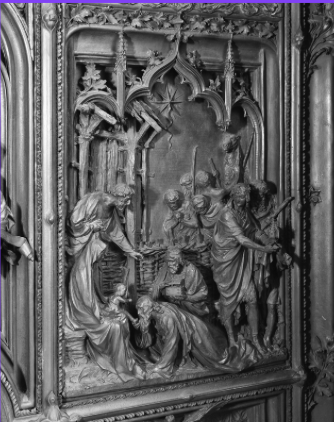
The Cathedral’s “Porta Maggiore” (the Main Door), cast in bronze according to the model by Lodovico Pogliaghi, portrays the joys (on the right side) and the sorrows (on the left side) of the Virgin Mary. Among the panels illustrating the joyful moments in Mary’s life, one depicts the Adoration of the Magi.
In his interpretation of this scene, Pogliaghi chose an iconography showing the eldest of the Magi kneeling bare-headed while kissing the feet of a Baby Jesus Christ.
When visiting the Duomo, people
typically take a tour of the interior or climb the stairs for a panoramic view from the Madonnina. While many admire its exterior from a distance, I highly suggest taking a closer look at the main entrance to truly feel the grandeur of the cathedral—appreciate the marble veins, its shades, the massive main door, and the intricate details of the bronze high-relief.
For a unique experience, consider going at night. No crowds, no chaos, and a more romantic atmosphere 😉
Always on the theme of Adoration, one small gem that we recommend you explore in Milan is actually located in the most notorious and photographed monument in the city: the Duomo… more precisely, its main door.
The design for the façade of the Duomo di Milano, conceived by Tibaldi, included five doors: a large central one and two smaller ones on each side.
Exhibition “San Francesco, il Natale e Greccio: Variazioni sul tema della Natività tra Italia e Fiandre”, recommended by Anna
NOVEMBER 12, 2023 -FEBRUARY 3, 2024
MUSEO DEI CAPPUCCINI, MILANO
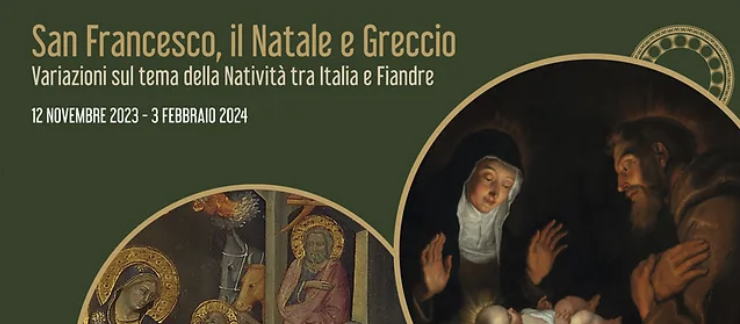
The theme of the “Adoration” holds a central place in Christian art, portraying profound moments of reverence and homage. At its core is the depiction of individuals paying homage to the divine, often centered around significant biblical events, with the adoration of the Magi and the adoration of the shepherds being prominent examples.
In honor of the significant anniversary of Christmas at Greccio (1223-2023), Museo dei Cappuccini wishes to commemorate Saint Francis of Assisi’s decision to celebrate the Christmas Eve with a sacred representation, much like a living nativity scene.
The saint’s new vision paved the way for the history of Nativity representation, with a particular focus on the theme of the Adoration of the shepherds—a choice that became especially important for the development of the Mendicant Orders in the 13th and 14th centuries.
Therefore, many fundamental works (from the 14th to the 18th century) related to the Adoration will be showcased alongside others related to the Nativity.
The Artwork
“Monaco Monte Carlo”, by Alphonse Mucha (1897), recommended by Giorgio
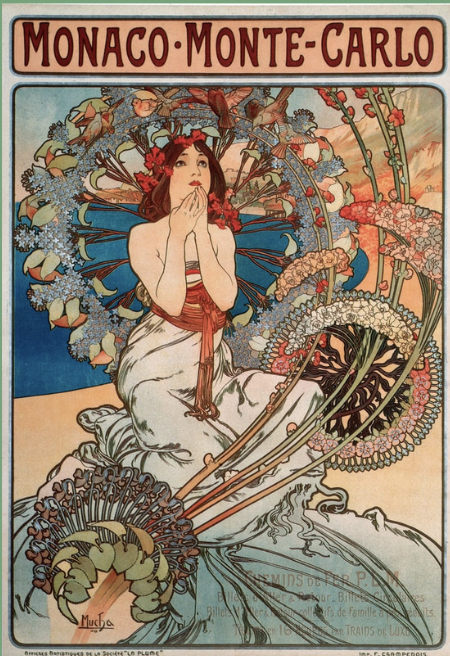
The word “adoration” takes its origins from the Latin verb “adorare”, which conjures up the idea of clasping hands to the mouth while feeling entranced. The same kind of astonishment seems to take over the girl in this poster by Alphonse Mucha, which
advertised a railway company.
The model is supposedly daydreaming about visiting ‘La Côte d’Azur’, and yet, something much deeper than commercials craves to unfold, as the fading background could suggest. Some may argue that his posters were meant to worship the idols of the time (like the actress Sarah Bernhardt) and arouse material, consumeristic desires. Be that as it may,
his works hint at a more intrinsic object of worship – the unfathomable mystery behind a blooming flower, a singing bird, the feeling of being visited by a memory. Moreover, this Czech-born artist was unstintingly meditating on spirituality, as it is proved by his illustrated book “Le Pater” and his commitment, as he said, “to communicate a spiritual message”.
Therefore, instead of deluding himself into a superficial world, Mucha might be suggesting that adoration can be enhanced by material goods too – as much as they cling to the hope of a greater truth.
“Ascension”, by Salvador Dalì (1957), recommended by Anna Dalaidi
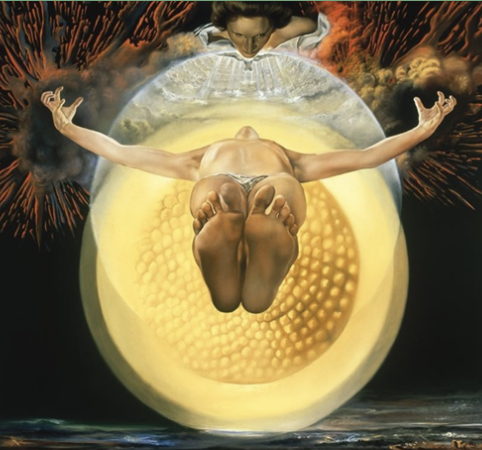
When discussing adoration in art, our mind is immediately drawn to the masters of the past: scenes of nativity, representations of the holy family, and biblical imagery. The Ascension of Christ is a modern take on those subjects, that Dali painted inspired by the artistry of Caravaggio and Rembrandt.
The artist puts himself in the desecrating position of an apostle, seeing the ascension from below as if he were present. He admires the body of Christ depicted in a motion that draws a triangle,from his feet to his arms: an allegory of the Trinity and a crucifix-like shape.
On the top of the painting, where God is logically supposed to be located, we see a woman: Dali’s venerated wife. By that time, the artist had already depicted her as the Virgin Mary in many paintings, and here (with a sacrilegious choice) she substitutes the Creator.
The nucleuses painted behind the body are to the artist the real representation of the divine, as it appeared in a lucid dream to the artist eight years before the realization of the piece. This drawing, with his golden colors and bright essence, recalls a sunflower: the plant follows the sun like Christ ascends to God, in the same adoring and trusting manner.